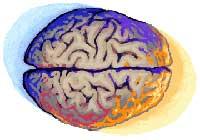Evolution of the brain
2001/05/11 Galarraga Aiestaran, Ana - Elhuyar Zientzia
Knowing what is the cerebrotype of an animal, it is easy to imagine which group it belongs to. In fact, although the brains of the animals of the same group are of very different size, the proportions between the fields are similar, that is, they have a similar cerebrotype.
The change of cerebrotypes indicates an evolution. For example, the footprint of the path that goes from primitive slogans to primates and to the human being is seen in the relative prolongation of the neoortex, the last one that has evolved from the zones and that is considered matter of the intelligence, among other things because in it the capacities of learning and speaking are placed. It occupies 80% of the human brain, but in the most evolved monkeys only 60%. According to the researchers, this difference is an example of better adaptation to live in groups with a more complex social structure.

Researchers have also observed similarities in remote species. For example, the bat and dolphin use a localization system by echo and both species have a lot to see.
However, explaining the evolution of the brain is not so simple. An anthropologist at the University of Durham, Great Britain, has used another method to compare brain zones and does not conform to the results of Princeton researchers. According to their study, the cerebellum has a similar proportion in most species, so they concluded that its function does not depend on other areas.
However, the work of the anthropologist at the University of Durham shows that in primates with great neoortex, the cerebellum also has a greater dimension. Therefore, only by analyzing the proportions, one cannot know how to change each area of the brain with respect to other areas.
Other researchers, however, consider that both studies are complementary. They propose that comparing the number of cells can be a better method than comparing volumes. Undoubtedly, there are still many studies to be done, but it seems that steps are being taken to explain the evolution of the brain.

Gai honi buruzko eduki gehiago
Elhuyarrek garatutako teknologia





